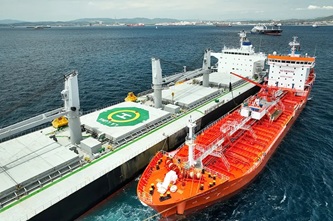


Bunker fuel is shifting with market growth, tighter carbon rules, and rising use of LNG, methanol, and ammonia as cleaner marine fuel alternatives.
The bunker fuel market continues its upward trajectory. Industry reports estimate market value rising from approximately USD 126.1 billion in 2024 to around USD 192.2 billion in 2034, representing a growth rate near 4.41%
Despite market growth, demand may plateau. The International Energy Agency (IEA) projects that global marine fuel demand may stabilize at around 5 million barrels per day from 2024 to 2030, due to economic headwinds and tighter emission standards. Regulatory pressure is mounting: IMO’s carbon pricing mechanism, slated for adoption in October 2025 and enforcement starting 2028, will penalize vessels that exceed emissions targets. Similarly, the EU’s FuelEU Maritime regulation, effective January 1, 2025, will increase costs for ships operating in its waters, potentially raising freight rates.
The industry is increasingly embracing cleaner fuels. A landmark development in the U.S.: construction of the Galveston LNG Bunker Port in Texas, the Gulf Coast’s first LNG bunkering terminal, is underway—with a targeted 2027 completion and capacity of 720,000 gallons per day. In Asia, LNG bunker supply is also expanding—S&P forecasts a 7% year-over-year rise in LNG availability in 2025, supported by dual-fuel ships entering service.
On the biofuel front, FAME-based biofuel blends, notably B30 RF, are gaining traction in ports like Singapore, Algeciras, and Antwerp, buoyed by new standards (ISO 8217:2024 and IMO MEPC 83) that categorize blends up to 30% as conventional fuel—streamlining compliance with NOₓ regulations.
Innovative fuel technologies are advancing rapidly. Trials of next-generation bio-bunker blends have been successfully conducted—for instance, TotalEnergies Marine Fuels completed a promising trial in mid-2025. Meanwhile, wind-assisted propulsion is experiencing a renaissance: vessels like the Grain de Sail II reflect a renewed interest in sail-powered, low-carbon shipping, and wind systems are being retrofitted on cargo ships with fuel savings up to 40%.
Moreover, new fuels like green ammonia and e-methanol are under active development. Companies such as Fortescue and Maersk are piloting dual-fuel vessels and supply chains, although cost and infrastructure remain barriers.
Debates continue over incentives. Maersk has warned that IMO’s proposed emissions trading scheme might favor LNG—making it possibly cheaper than greener options like methanol—risking a “lock-in” effect for fossil-based cleaner fuels. This debate is critical as regulators seek to design mechanisms that genuinely promote sustainable adoption rather than merely shifting preferences.
Final Thoughts
The bunker fuel industry in 2025 is in the eye of transformation—driven by market growth, regulatory tightening, and accelerating adoption of alternative fuels. While demand may flatten under emissions frameworks, uptake of LNG, biofuels, and emerging solutions like ammonia and wind-assisted propulsion signals a strategic shift. The balance between cost, compliance, and ecological impact will determine how shipping adapts to a net-zero future.
